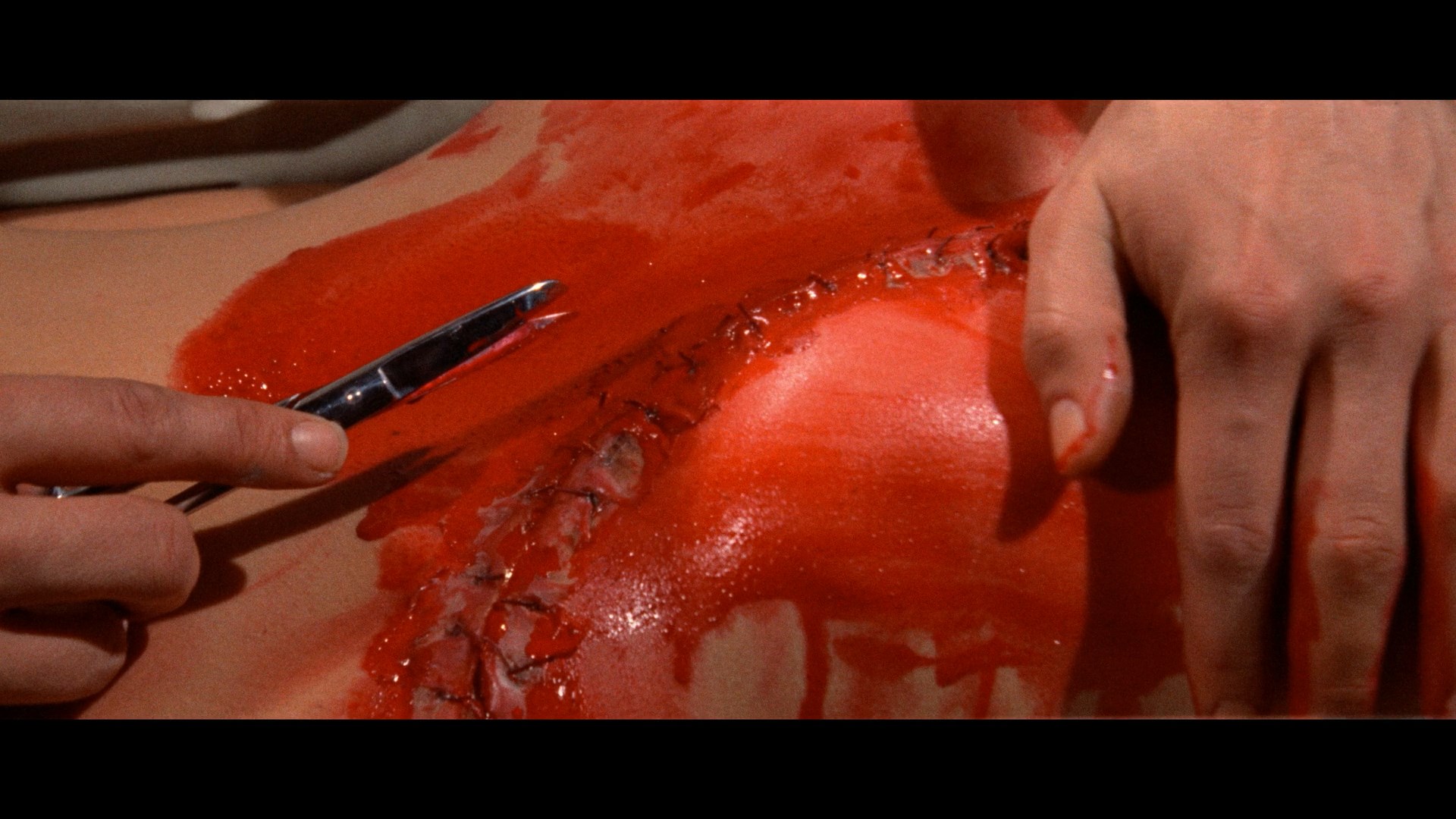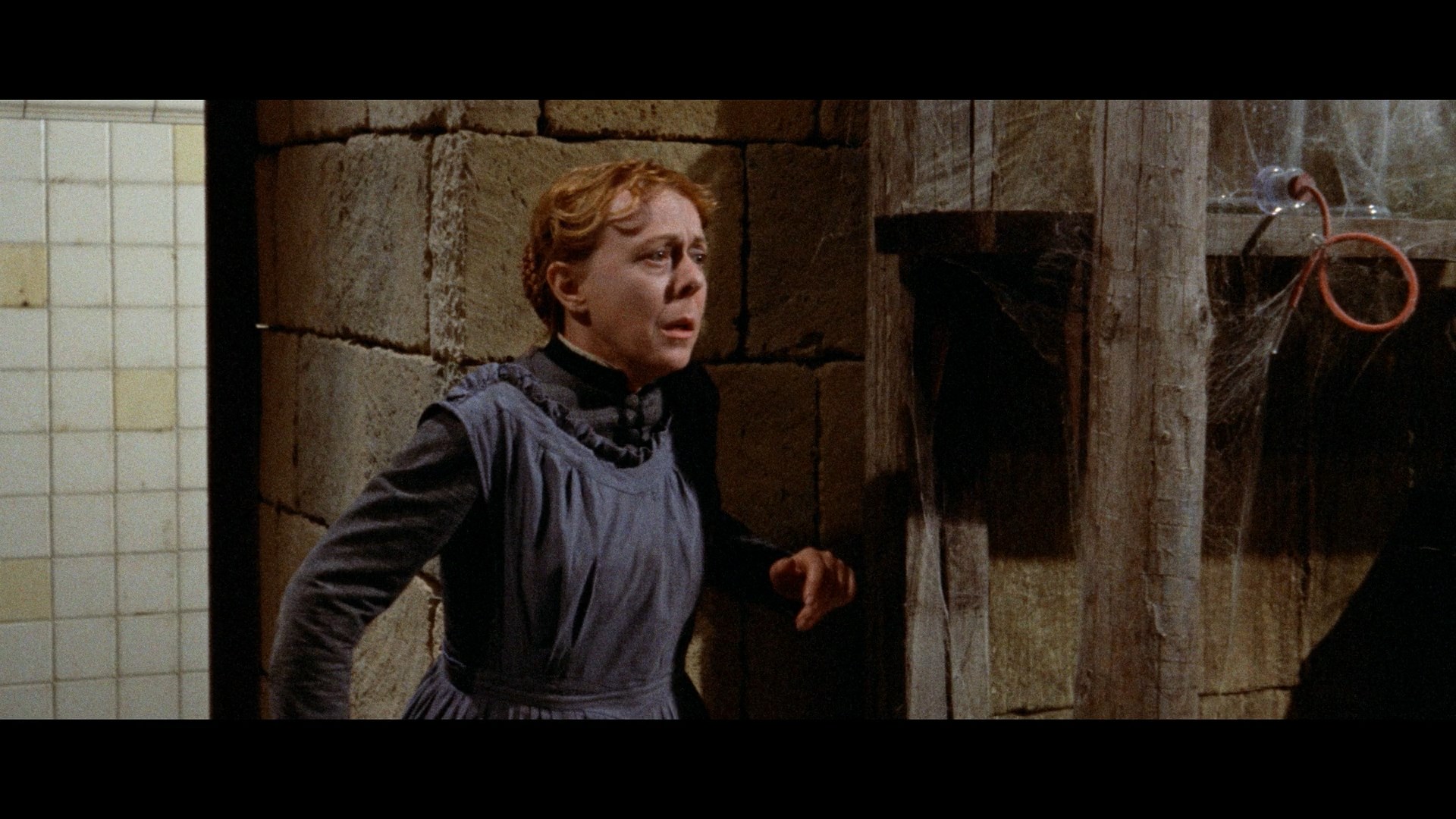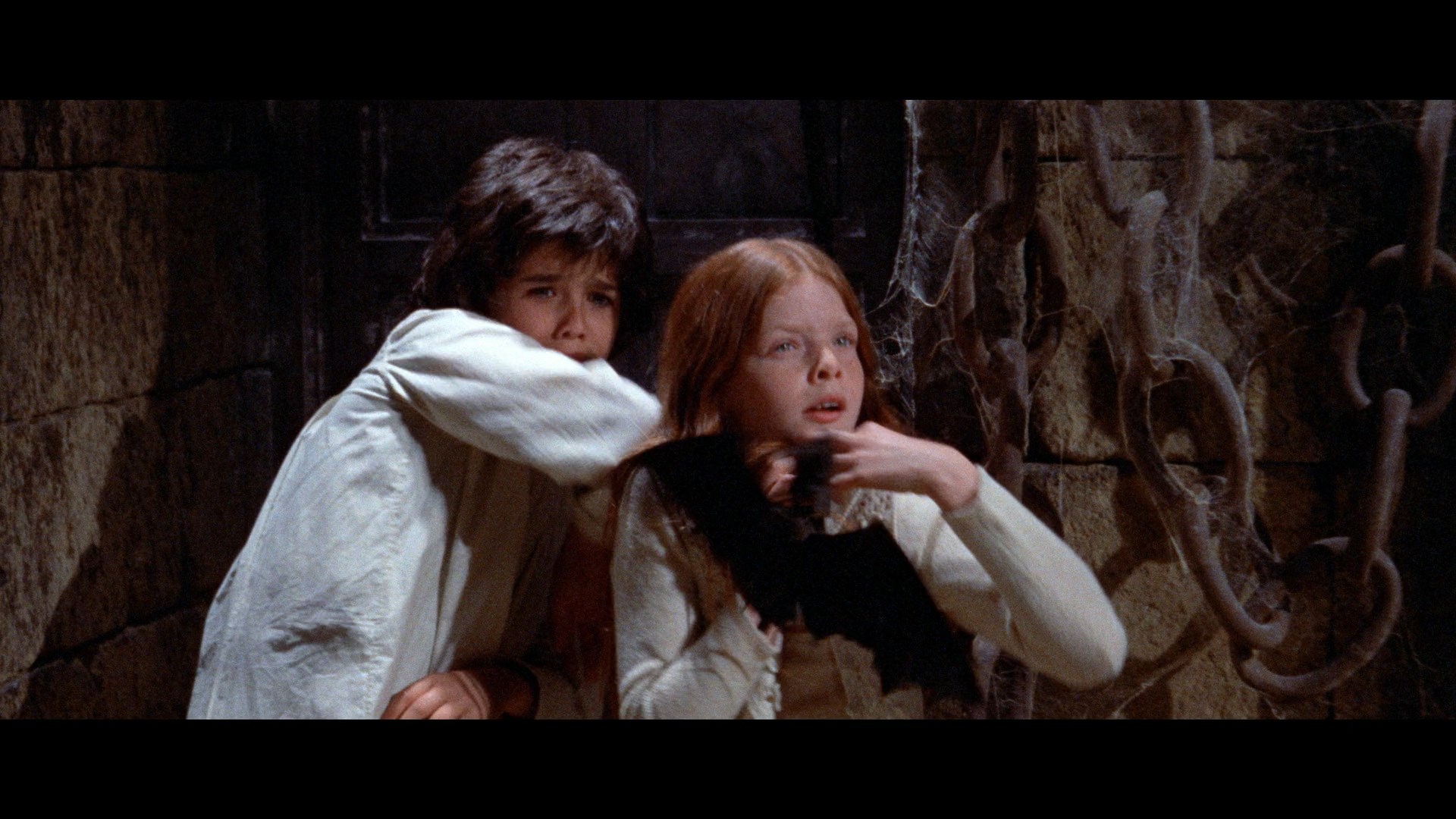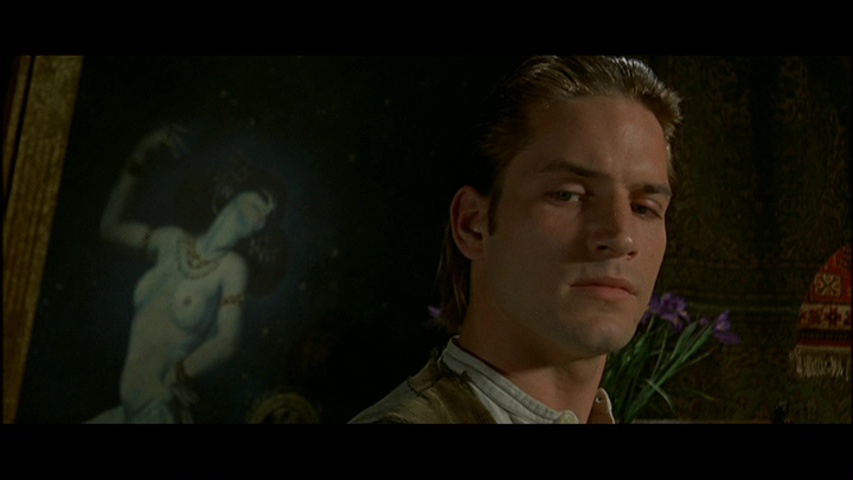

Color, 1973, 95 mins. 10 secs.
Directed by Paul Morrissey
Starring Joe Dallesandro, Monique van Vooren, Udo Kier, Arno Jürging, Dalila Di Lazzaro, Srdjan Zelenovic, Nicoletta Elmi, Marco Liofredi
Vinegar Syndrome (UHD and Blu-ray) (US R0 4K/HD), Cinema Cult (Blu-ray & DVD) (Australia R0 HD/PAL), Happinet (Blu-ray & DVD) (Japan RA/R1 HD/NTSC), Image Entertainment (DVD) (US R1 NTSC) / WS (2.35:1) (16:9), Criterion (DVD) (US R1 NTSC) (2.35:1)
 smacked in the face with Flesh for Frankenstein, a 3-D collision
smacked in the face with Flesh for Frankenstein, a 3-D collision  of European horror and Andy Warhol's Factory under the guiding hand of director Paul Morrissey, who brought over his most famous underground star and trailblazing male sex symbol, Joe Dallesandro (Flesh, Trash, Heat). Released with an X rating for its outrageous dollops of gory body parts and softcore sex, the film is essentially a twisted black comedy of manners at heart that turned out so well a non-3-D successor started shooting right away, Blood for Dracula. It's no coincidence that Hammer Films was about to wrap up its own Frankenstein cycle when this film opened as the entire game had changed by this point; when confronted with the spectacle of Kier's delirious climactic monologue complete with an innard about to plop in the audience's lap, we clearly weren't in classic monster movie territory anymore.
of European horror and Andy Warhol's Factory under the guiding hand of director Paul Morrissey, who brought over his most famous underground star and trailblazing male sex symbol, Joe Dallesandro (Flesh, Trash, Heat). Released with an X rating for its outrageous dollops of gory body parts and softcore sex, the film is essentially a twisted black comedy of manners at heart that turned out so well a non-3-D successor started shooting right away, Blood for Dracula. It's no coincidence that Hammer Films was about to wrap up its own Frankenstein cycle when this film opened as the entire game had changed by this point; when confronted with the spectacle of Kier's delirious climactic monologue complete with an innard about to plop in the audience's lap, we clearly weren't in classic monster movie territory anymore. assistant, Otto (Jürging). Their current project is assembling the perfect race by assembling male and female parts into a Nietzschian couple, which means using the head of a man with the perfect libido. However, a misunderstanding at a brothel has them using their beheading
assistant, Otto (Jürging). Their current project is assembling the perfect race by assembling male and female parts into a Nietzschian couple, which means using the head of a man with the perfect libido. However, a misunderstanding at a brothel has them using their beheading  shears on Sacha (Zelenovic), a sexless would-be monk dragged there by his Brooklyn-accented best friend, farmhand Nicholas (Dallesandro). Neglected in bed by the Baron, the Baroness decides to bring Nicholas into the household as her own domestic servant and lover, a situation that turns into a bloody family comedy when the Baron starts to unveil his latest creations including a perfect female (The Pyjama Girl Case's Di Lazzaro) to the household.
shears on Sacha (Zelenovic), a sexless would-be monk dragged there by his Brooklyn-accented best friend, farmhand Nicholas (Dallesandro). Neglected in bed by the Baron, the Baroness decides to bring Nicholas into the household as her own domestic servant and lover, a situation that turns into a bloody family comedy when the Baron starts to unveil his latest creations including a perfect female (The Pyjama Girl Case's Di Lazzaro) to the household. Gizzi, who had just debuted with What? for Roman Polanski, reputedly the instigator of the idea for a 3-D horror film to producer Carlo Ponti (who would later become a brief tabloid sensation for
Gizzi, who had just debuted with What? for Roman Polanski, reputedly the instigator of the idea for a 3-D horror film to producer Carlo Ponti (who would later become a brief tabloid sensation for  his reported affair with Di Lazzaro).
his reported affair with Di Lazzaro).  Farmer!" and of course, "To Know Death, Otto..." After that things got sparse for a very, very long time, with Morrissey holding onto the rights apart from legally dubious Blu-ray editions in Australia (featuring a
Farmer!" and of course, "To Know Death, Otto..." After that things got sparse for a very, very long time, with Morrissey holding onto the rights apart from legally dubious Blu-ray editions in Australia (featuring a  highly unconvincing upscale of the SD Image master) and Japan (with fogged-out frontal nudity). Of course, anyone pining for a 3-D release of any kind was also left out in the cold for decades apart from a scarce Japanese VHS, letterboxed and looking quite nice for the time with effective use of a process also used for stereoscopic editions of films ranging from Friday the 13th Part 3 to Rottweiler.
highly unconvincing upscale of the SD Image master) and Japan (with fogged-out frontal nudity). Of course, anyone pining for a 3-D release of any kind was also left out in the cold for decades apart from a scarce Japanese VHS, letterboxed and looking quite nice for the time with effective use of a process also used for stereoscopic editions of films ranging from Friday the 13th Part 3 to Rottweiler. is
is  considerably heightened, resulting in an experience that could be described as Flesh for Frankenstein on steroids. If you really want this movie in your face with clarity straight off the neg, here you go! The standard Blu-ray looks gorgeous throughout with no issues and replicating the theatrical appearance perfectly, improving tremendously on the older transfers by leaps and bounds. Basically, try any of the formats you possibly can and see which one fits your sensibilities best. The DTS-HD MA English 2.0 mono audio sounds great (armpit slurping has never been so clear) and is identical no matter which version you watch, with optional English SDH subtitles.
considerably heightened, resulting in an experience that could be described as Flesh for Frankenstein on steroids. If you really want this movie in your face with clarity straight off the neg, here you go! The standard Blu-ray looks gorgeous throughout with no issues and replicating the theatrical appearance perfectly, improving tremendously on the older transfers by leaps and bounds. Basically, try any of the formats you possibly can and see which one fits your sensibilities best. The DTS-HD MA English 2.0 mono audio sounds great (armpit slurping has never been so clear) and is identical no matter which version you watch, with optional English SDH subtitles. the actor in fine storytelling form as always
the actor in fine storytelling form as always  as he recounts his childhood path to his chosen career through England and Germany before going into his first meeting with Morrissey, the belated call that led to his casting, and the cinematic adventure that would lead to a pair of masterpieces. As with most other accounts of the film, he verifies that there wasn't really a finished script per se as much as an outline was scripted out each day, a bit of a challenge for the performers who weren't entirely comfortable with English. Next up is Dallesandro for "In the Flesh" (12m48s), explaining how his U.S. films with Morrissey and Warhol paved the way to this film and his European career, noting the difficulty of shooting in 3-D and providing the cutest moment about how he had to tap his toes to signal his European costars when to say their lines. In "Dimension in Fear" (11m16s), producer Andrew Braunsberg starts off with the whole Polanski genesis before recalling the pleasant collaborative working process with Morrissey and the efficient shooting process apart from the 3-D issue, due to Morrissey's bad vision in one eye. In "Andy's Shadow" (15m31s), Stephen Thrower provides a fine companion piece to his appearance on Dracula with an appraisal of Morrissey's directorial style and the importance of his work, evolving from the ragged shock of Flesh to the film at hand with a couple of aborted projects along the way (Cruising! Sherlock Holmes!) before settling into the story behind this film including its European financing, the complete lack of Warhol involvement, the shooting locations including Cinecittà, the divided critical reaction, and more. "Building the World of Frankenstein" (28m31s)
as he recounts his childhood path to his chosen career through England and Germany before going into his first meeting with Morrissey, the belated call that led to his casting, and the cinematic adventure that would lead to a pair of masterpieces. As with most other accounts of the film, he verifies that there wasn't really a finished script per se as much as an outline was scripted out each day, a bit of a challenge for the performers who weren't entirely comfortable with English. Next up is Dallesandro for "In the Flesh" (12m48s), explaining how his U.S. films with Morrissey and Warhol paved the way to this film and his European career, noting the difficulty of shooting in 3-D and providing the cutest moment about how he had to tap his toes to signal his European costars when to say their lines. In "Dimension in Fear" (11m16s), producer Andrew Braunsberg starts off with the whole Polanski genesis before recalling the pleasant collaborative working process with Morrissey and the efficient shooting process apart from the 3-D issue, due to Morrissey's bad vision in one eye. In "Andy's Shadow" (15m31s), Stephen Thrower provides a fine companion piece to his appearance on Dracula with an appraisal of Morrissey's directorial style and the importance of his work, evolving from the ragged shock of Flesh to the film at hand with a couple of aborted projects along the way (Cruising! Sherlock Holmes!) before settling into the story behind this film including its European financing, the complete lack of Warhol involvement, the shooting locations including Cinecittà, the divided critical reaction, and more. "Building the World of Frankenstein" (28m31s)  features art director Gianni Giovagnoni explaining how the rare 3-D process at the time impacted the project, the appeal of working on what he thought would be a Warhol film, his memories of the shoot, the concept of shooting those insane long dinner table scenes,
features art director Gianni Giovagnoni explaining how the rare 3-D process at the time impacted the project, the appeal of working on what he thought would be a Warhol film, his memories of the shoot, the concept of shooting those insane long dinner table scenes,  and a gradually shrinking souvenir he kept that now resides by his bed. Then in "Don't Say a Word" (13m1s), actress Liù Bosisio notes how she insisted on a silent role because she couldn't speak a lick of English for the role of mute housekeeper Olga, though she definitely enjoyed the experience of the film. Finally in "Feed My Frankenstein" (16m27s), assistant director Paolo Pietrangeli relates how he made the two Morrissey films in a joyous contrast to his usual work with Italian cinematic maestros, the annoyance of the Italian tax requirements that led to him being credited on the Margheriti material, the Italian crew members' phallic nickname for Dallesandro on the set, and the bittersweet nature of how much he actually got to interact with the two visiting Americans. (For some reason this segment has full English SDH subtitles instead of just translated ones, which plays oddly.) Morrissey pops up again for raw Q&A footage from 2012 (33m37s) chatting more generally about his career and memories of Warhol and the music scene with Art Ettinger and Louis Paul; it's roughly shot on a VHS camcorder but worth seeing for posterity, especially since it closes out on a very goofy note about his TV viewing habits. You also get the the scope European theatrical trailer in gorgeous quality; absent here are the original Bryanston U.S. trailer and the fantastic 1982 reissue one, but you can find them in fine quality on Trailer Trauma and Trailer Trauma 2. Finally you also get 1m7s of radio spots from the U.K. and the U.S., plus
a 7m26s gallery of international poster art and stills.
and a gradually shrinking souvenir he kept that now resides by his bed. Then in "Don't Say a Word" (13m1s), actress Liù Bosisio notes how she insisted on a silent role because she couldn't speak a lick of English for the role of mute housekeeper Olga, though she definitely enjoyed the experience of the film. Finally in "Feed My Frankenstein" (16m27s), assistant director Paolo Pietrangeli relates how he made the two Morrissey films in a joyous contrast to his usual work with Italian cinematic maestros, the annoyance of the Italian tax requirements that led to him being credited on the Margheriti material, the Italian crew members' phallic nickname for Dallesandro on the set, and the bittersweet nature of how much he actually got to interact with the two visiting Americans. (For some reason this segment has full English SDH subtitles instead of just translated ones, which plays oddly.) Morrissey pops up again for raw Q&A footage from 2012 (33m37s) chatting more generally about his career and memories of Warhol and the music scene with Art Ettinger and Louis Paul; it's roughly shot on a VHS camcorder but worth seeing for posterity, especially since it closes out on a very goofy note about his TV viewing habits. You also get the the scope European theatrical trailer in gorgeous quality; absent here are the original Bryanston U.S. trailer and the fantastic 1982 reissue one, but you can find them in fine quality on Trailer Trauma and Trailer Trauma 2. Finally you also get 1m7s of radio spots from the U.K. and the U.S., plus
a 7m26s gallery of international poster art and stills.








